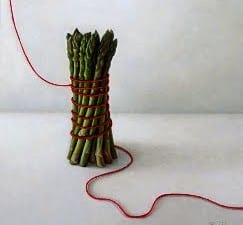Between 1947 and 1949, Barbara Hepworth produced around 80 works of surgeons at work in operating theatres. This period of activity followed the friendship that resulted from the hospitalisation of the daughter of Hepworth (and Ben Nicholson) with the surgeon who treated her at the Elizabeth Orthopaedic Hospital, Exeter: Norman Capener. The invitation to witness surgical procedures both at Exeter and the London Clinic bore the fruit now showing in Gallery 7 of The Hepworth, Wakefield. Speaking in a lecture to an audience of surgeons in the late 1950s, Barbara Hepworth said: “There is, it seems to me, a close affinity between the work and approach both of physicians and surgeons, and painters and sculptors”. Certainly, what is captured with the greatest acuity and feeling in The Hospital Drawings of the surgeons are those physical elements most salient to adroitness: the eyes and the hands. However, as we consider the socio-historical context, certain other elements in the style of the work have broader resonance: The Hospital Drawings are to be viewed within the context of the launch of the NHS in 1948.
What is most striking, given the general feeling of benevolence, duty and social solidarity of this part of historical context, is the sense of religious piety and ecstasy. For example, in the case of the oil and pencil piece, Skigram (1949), the viewer is presented with three surgeons from the waist upwards. They wear ochre gowns and headwear, along with surgical masks, and they are set against a blue background. Their hands are held at chest height almost touching, in the interest of hygiene of course; but owing to the delicacy and accuracy in the execution of the hands, which is highly reminiscent of such delicacy in religious painting earlier in the Western canon, they seem to be held in prayer. The gaze of the surgeons seems to be directed into the middle distance and can be felt to impart a sort of ecstatic piety. What compounds these general connotations of the religious is the method, employed by Hepworth in most of the work, of scratching at the areas of colour – this brings a sense of the heavenly ethereal to the work.
This religious element can be felt in two pieces from 1948, Pause 7 and Prevism. Here, the colouring is beige, and the surgeons are somewhat Priest-like, their gowns and headwear lending a sterile sort of formality. The same can be said of the surgeons at work in four striking pieces from 1948, in which the surgeons work as a group. In Quartet (Arthroplasty), Fenestration of the Ear (The Lamp), Fenestration of the Ear (Microscope) and Fenestration of the Ear (The Hammer), the heavenly ethereal scratching is applied to the Priest-like surgeons as they gaze in ecstatic piety. However, here, as they gather around the patient at different angles, the accurately and delicately captured hands operating with precision allude to sense of anointment. The focus around which the concerted action takes place has this resonance at least because something very important and esoteric is happening there.
In the work, The Scalpel II (July 1949), the scratching method is extended beyond the effect of creating the ethereal. In the case of the figure of the surgeon holding the scalpel, the coloured background surrounding his head has either been scratched away completely or has been absent in the application. This creates a corona-like effect; he seems to have a Saintly halo. What appears to be a reference to religious painting in the Western canon is repeated again in the piece, Theatre Group III. Here, the large, circular light that illuminates the operating area appears behind the head of a surgeon at work.
In addition to these resonances, the striking and arresting work invites the viewer to consider the ways in which Hepworth’s sculptural ideas are conveyed in these drawings and paintings. The sense of life and motion captured in the bodily elements of the drawings speaks of this. What is most gratifying is the convenience with which cross-references can be made with the permanent collection at The Hepworth by the visitor.
Barbara Hepworth: The Hospital Drawings, Until 3 February, The Hepworth Wakefield, Gallery Walk, Wakefield, West Yorkshire, WF1 5AW
Daniel Potts
Credits
1. Barbara Hepworth, Concentration of Hands II, 1948, Private Collection © Bowness, Hepworth Estate. Image courtesy of Hazlitt Holland-Hibbert.
2. Barbara Hepworth, Prelude II, 1948, The Fitzwilliam Museum, Cambridge ©Bowness, Hepworth Estate, Image courtesy of The Fitzwilliam Museum, Cambridge.




